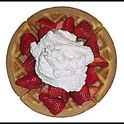How long can a cheesecake stay unrefrigerated?
I made Smitten Kitchen's New York Cheesecake last night, it came out of the oven at 10pm, and didn't make it into the fridge until 6am. (The kitchen temp is set at 55 degrees overnight). Am I going to keel over if I eat it?
14 Comments
JustTempieApril 24, 2021
I'm eating my left-out cheesecake. I will let you know the outcome. :)
ChefOnoNovember 20, 2013
Cold doesn't kill bacteria (nor deactivate the toxins some of them produce). The colder the environment, the slower bacteria reproduce until the temperature drops below freezing whereupon all biological activity stops. But when it rises again, there they are.
Six hours -- especially without knowing how the product was cooled after it came out of the oven or how many hands have touched it since -- is way too long. A lifetime of leftover cheesecakes doesn't add up to the cost of one trip to the hospital.
(Harry Callahan offers a slice of cheesecake) "I know what you're thinking, punk. You're thinking 'was this sitting around for six hours or only two?' Now to tell you the truth I forgot myself in all this excitement. But being this is a PHF, the ideal environment for growing bacteria and could turn your guts inside out, you've gotta ask yourself a question: 'Do I feel lucky?' Well, do ya, punk?"
PegeenNovember 20, 2013
ellenl, you're right, food is often left out longer, sometimes by sheer necessity (serving large groups where bagging the leftovers too early would seem rude, like Thanksgiving, and would interrupt the meal). I think a big factor is that people feel guilty about throwing away leftovers, even if they've been sitting out too long. It comes down to education about food safety. And learning not to over-do quantities.
I've had food poisoning twice from food that was left at room temp too long. A bunch of us were affected so we could trace a common event and dish. I was seriously sick for a few days, like having a very bad flu. Can require hospitalization.
I've had food poisoning twice from food that was left at room temp too long. A bunch of us were affected so we could trace a common event and dish. I was seriously sick for a few days, like having a very bad flu. Can require hospitalization.
PegeenNovember 20, 2013
I appreciate this educational info very much. Many cooks know the general rules of thumb but it's very interesting to learn about the science.
Curt B.November 20, 2013
ChefOno, if a cheesecake was left out for 6 hours or longer, and worse case scenario, E. coli or salmonella were growing in the cheesecake, would refrigerating or freezing the cheesecake after that period of time kill off the bacteria, rendering it safe to eat?
ellenlMarch 16, 2013
I may be different than many about this stuff. When you go to parties the food is out longer. I don't worry about iut and have never had a problem.
ChefOnoMarch 16, 2013
"Would", no. "Could", no question about it. The aw / pH combination tells us the potential is there; what we can't determine with any certainty is how long it would take for a dangerous situation to build up; there are simply too many unknowns. This is why we have to depend upon food safety rules to make these kind of decisions. Breaking them, either accidently or intentionally, is why 1 out of every 6 of us end up with food poisoning every year.
Yogurt, at least commercially produced yogurt, is not a PHF because, although it has a high aw, its pH is low enough (acidic) that most pathogenic bacteria can't survive. There are strains of E. coli and other dangerous bacteria that are acid-tolerant which is why the milk should always be pasteurized and the inoculation culture should be from a known, trusted source. As long as there is no subsequent contamination (sealed container), yogurt can remain unrefrigerated for quite some time without (ahem) ill effects.
So how does one determine which foods require strict refrigeration and where the rules may be safely bent? We all know some exceptions (cookies and bread) but even if you can wrap your head around time / temperature / moisture / acidity calculations, measuring aw and pH require laboratory equipment and guessing can get you into trouble faster than potato salad will spoil at a picnic. The simplest method is to follow the USDA's 2-hour danger zone rule and, when in doubt, throw it out. Conversely, refrigeration is virtually never harmful.
ATG117March 16, 2013
ChefOno, at the end of the day, does your response imply that you believe one would get sick from eating said cheesecake? I am always very careful in terms of cleanliness and bacteria of other sorts (from raw chicken, for instance), but I do find that I am more lax about keeping things at room temp without thinking much about it. I do this with yogurt often when I tote it around with me during the day. How terrible in practicality?
Lindsay-Jean H.March 14, 2013
Groan. I think I knew that was coming ChefOno... Thank you all!
ChefOnoMarch 14, 2013
It is not moisture per se that creates a potentially hazardous food (PHF) but the water activity levels (aw) in combination with acidity levels (pH). Furthermore, moisture is not directly equivalent to aw. Aw is the ratio between water vapor pressure and total water content. Clear as mud? To put it another way, apparent moisture (or lack thereof) is not an indication of potentially hazardous food.
Cheesecake is classified as a high moisture food product with an aw typically between .90 and .95 So unless the pH is below 4.2, it's a PHF and should be handled accordingly. Aw is an accurate and reliable method of calculating risk and laboratory test have demonstrated that even properly cooked cheesecakes (160F at center of mass) will support growth of Salmonella Enteritidis and other foodborne pathogens.
ChefOnoMarch 14, 2013
Cheesecake, perhaps surprisingly until you think about it, is a custard and falls under USDA rules for potentially hazardous foods -- no longer than 2 hours > 40F (consumer rules). You also exceeded commercial rules by perhaps twice the allowable time limit. Notice how both posters above "think" you'll be fine? They're your dice; I'm glad I don't have to make that call.
To the WF customer above, spoilage bacteria produce off flavors and smells, pathogenic bacteria (usually) do not.
boulangereMarch 14, 2013
The general rule is that you have 6 hours to cool food to 40 degrees or below. Within 2 hours, it needs to cool to 70 degrees, then to 40 within 4 more hours. Cheesecake is very forgiving, as it is very low in moisture. I think you'll be just fine to go ahead and serve it.
A Whole Foods Market CustomerMarch 14, 2013
I think you're safe. Cheesecake is better at room temperature but best stored cold.
Figure it didn't cool completely until about 12 am. At that point it sat for about 6 hours. You can leave cream cheese out for about 6 hours but not much more than that. Give it the ole sniff and taste test. If it's a little sour than don't risk it.
Figure it didn't cool completely until about 12 am. At that point it sat for about 6 hours. You can leave cream cheese out for about 6 hours but not much more than that. Give it the ole sniff and taste test. If it's a little sour than don't risk it.
Showing 14 out of 14 Comments
Recommended by Food52
Popular on Food52
Continue After Advertisement


